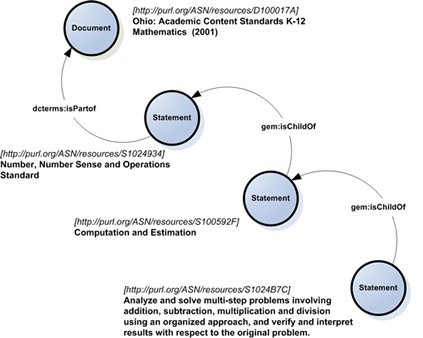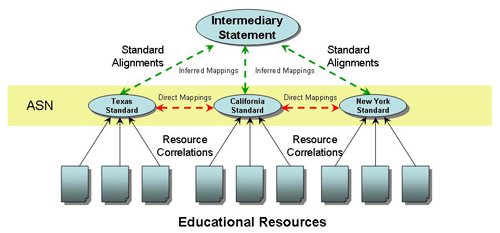ASN-DL Overview—Briefing #1
- URL:
- https://ld4pe.dublincore.org/asn-briefing-1/
- Editors:
- Joseph Chapmann (Desire2Learn)
- Stuart A. Sutton (Information School, University of Washington)
- Last Update:
- 2015-07-01
Licensed under a Creative Commons Attribution 4.0 International License.
Basic ASN Architecture
The ASN is made up of two fundamental entities: (1) standards documents, and (2) statements. ASN takes each standards document as it is produced by its official promulgating agency and “atomizes” its content into atomic statements. These two entities—documents and statements—are framed in terms of an entity-relationship model (ER) and embodied in RDF/XML (Resource Description Framework). Both structural and semantic relationships between the ASN’s primary entities—the standards document entity and its atomic statement entities—have been defined.
The following diagram illustrates the use of the document and statement entities in expressing a single standard in the Ohio 2001 mathematics standard. The relationships between the entities in the diagram are hierarchical and are represented by the arrows in the diagram.
Note that each entity has been assigned a unique identifier in the form of a Uniform Resource Identifier (URI).
The diagram above illustrates what is called an ASN Taxon Path which is defined as a single traversal of a branch of a standards document–here from the root (i.e., the standards document description) to a leaf (i.e., a statement at some arbitrary level in the branch hierarchy). Just as the atomizing of the text de-contextualizes the standard document’s member statements for unique identification and reference, the notion of the ASN Taxon Path re-contextualizes those statements. This re-contextualization is fundamental to human comprehension of the standards since many atomic statements, standing alone, convey insufficient meaning. As a result, all ASN services return full ASN Taxon Paths.
The following figure illustrates another ASN Taxon Path.
For the purpose of illustrating the notion of the ASN entities and relationships, the content of both of the ASN Taxon Paths illustrated above has been kept at a minimum. In fact, metadata describing additional attributes (e.g., subjects, grade levels, etc.) of both the standard document and statement entities are provided. Documentation of the ASN Application Profile is available.
Resolving (Dereferencing) an ASN URI
All ASN URIs can be resolved or dereferenced by humans or applications. The dereferencing of an ASN URI returns the full upward path of the ASN Taxon Path in which the entity identified by the URI is a member. Thus, dereferencing the ASN URI http://purl.org/ASN/resources/S1024B7C found in the Ohio mathematics example above returns an RDF/XML description of the full Taxon Path as illustrated including the text of its member statements.
If the statement URI being referenced is an entity further up in the hierarchical path from the literal leaf, dereferencing would treat the URI being dereferenced as the leaf entity in the Taxon Path and return the upward path. The Taxon Path in such a case would not include statements downward in the path from the dereferenced entity.
The dereferencing of an ASN URI is managed by the ASN URI Resolver. The ASN URI Resolver is the simplest service offered by the ASN and requires no special knowledge on the part of humans or applications to handle dereferencing.
Cross-Jurisdiction Mapping (Intermediary Services)
Intermediaries in the context of K-12 content standards are services that handle the mapping of an ASN state standards statement URI to a statement URI from another state. In other words, it is a service that draws a more or less rough equivalency relationship between standards statements in two separate standards documents. Those documents may be two versions of a single state’s standards or documents from two entirely different states. Intermediaries make it possible to fulfill the following sorts of end-user needs:
- I have an ASN URI for a standard from Nebraska, is there an equivalent standards statement in the Arizona standards?
- I have retrieved a very useful lesson plan that has been correlated to a Nevada standard but I live in California. What California standard might this lesson plan help me fulfill?
- I have retrieved a very useful lesson plan correlated to a Nevada standard using an ASN URI and I’d like to see whether there are other similar lesson plans I might use to meet my Nevada standard but which have been correlated to standards from other states using ASN URIs. Are there any such lesson plans?
While there are a number of existing and emerging intermediaries based on different theoretical and technical premises, they all basically function as illustrated in the following figure:
In the yellow ASN band across the figure, we see illustrative standards statements from Texas, California and New York. The mapping choices between the state standards are two-fold: (1) a service could do a one-to-many mapping from each state statement to its equivalent in each of the other state standards documents—a tedious, impractical process; or (2) a single set of all encompassing expressions (an intermediary) might be created that capture the content of all of the state standards that make it possible to map each state statement once to the intermediary and then to use that intermediary as a “switching language.” All intermediaries pursue some form of the second choice.
The ASN supports the design and development of any number of 3rd party intermediaries based on different principles and technologies.
Extending Granularity of an ASN Taxon Path
For some service providers consuming and using the ASN state standards, the level of granularity of leaf statements may not be sufficiently granular to meet all service purposes. For example, the following statement from an Ohio standard might be further atomized into sixteen additional, more granular statements based on the cognitive process (analyze, solve, verify, and interpret) and the task (addition, subtraction, multiplication and division):
“Analyze and solve multi-step problems involving addition, subtraction, multiplication and division using an organized approach, and verify and interpret results with respect to the original problem.” [http://purl.org/ASN/resources/S1024B7C]
The ASN makes it possible to increase the granularity of expression in a standards document by distinguishing between canonical (original) statements as promulgated by the standards bodies and non-canonical (derived) statements added by 3rd parties. Derived 3rd party ASN statements “refine” original statements by making more specific, granular assertions. Since derived statements are treated as first-class entities in the ASN, they are assigned URIs in the same manner as original statements and clearly identified as such. Of course, derived statements can be easily eliminate, not display, or treated in some manner as simple annotations by services consuming the standards documents.
As a result of this extensibility, any authorized 3rd party may directly create more granular statements in the ASN or without authorization in their own namespace and relate those statements to the canonical (original) statements using the ASN-identified structural relations in the ER model.
While these 3rd party derived statements may be included in the ASN repository, nothing precludes a service from creating its own namespace to handle its refinements of canonical ASN statements and exposing those refinements (or not) to the Web community.
The following figure illustrates this 3rd party “annotation” processes.
Example uses of the ASN refinement capability might include:
- Testing services creating assessment instruments that target only parts of canonical statements; or
- A school district wishing to refine its state’s ASN standards expressed in grade bands by breaking out facets of particular official statements by individual grades while still maintaining the semantic association with the state statement.
Expressing “Strength of Fit”
Frequently, it is useful to map from one resource to another to express the level of useful similarity between the two nodes. Such mappings may be from one competency framework node to another node in the same or another framework (i.e., competency-to-competency), or to map from a learning resource to a competency node (i.e., learning resource-to-competency). In ASN, the utility of that mapping is a function of its “strength of fit”. The ASN ontology provides an array of properties that express this strength of fit relationship in competency-to-competency mappings (called “alignments” in ASN) and learning resource-to-competency mappings (called “correlations” in ASN).
The table below includes brief descriptions of the current competency-to-competency mapping predicates. For the full description of both the competency-to-competency mapping properties and the learning resource-to-competency mapping properties, see Briefing Paper #2: ASN Ontology.












